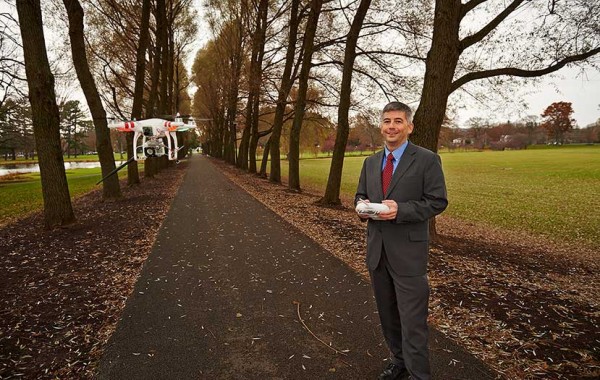Kevin Lynch
A bright yellow seaplane glides to an elegant splash landing on Taylor Lake, and Colgate’s chief information officer smiles. Kevin Lynch, a former communications and information officer in the Air Force, said he’s always had an aviation fascination. The model plane is a kit-built radio-controlled design powered by electric motors attached to propellers.
“Those motors were originally designed to spin CDs,” he explained. Lynch builds many of his planes with simple dollar-store foam board and hot glue. “This way, it’s only a couple of bucks if (when) I crash it,” he said.
Lynch took on the position of CIO in January of 2013, following 12 years at Clarkson University. He sees his role as facilitating communication on campus (he is responsible for visitors no longer having to register their devices to use campus WiFi) and helping to focus the creative tendencies of faculty, staff, and students.
Back in his office, as Lynch described the evolving role of technology on campus, Ahmad Khazaee ’05, instructional technologist, stopped by with the latest delivery — A MakerBot 3D printer. “That’s the first step in the creation of a maker’s space,” Lynch said of a room in the works that will provide students with the tools to make things ranging from small crafts to advanced models. “People can come together to make robots, interactive art, and prototypes for new ideas. Eventually, we’ll get a laser cutter and a soldering station.”
Lynch said he also applies an open, creative mind-set to project management within the department.
“IT is a service organization,” he said. “We’re here to help people use technology to become more productive and efficient, but our overriding goal is to increase the personal relationships between people. Technology should not be used as a barrier or a substitute [for personal interaction].”
And while Lynch is exceptionally easy to reach, he is rarely found in his office. Lynch prefers to be out and about on campus, helping people to brainstorm and solve problems. A recent project involved overseeing the setup of 27 wireless boosters to accommodate the crowd of more than 5,000 who came to see Hillary Clinton speak.
A father of four children ranging in age from 1 to 9, Lynch said his love of technology doesn’t mean his home is extra-wired for gadgetry. In fact, he is a “cord cutter,” eschewing cable television in favor of Netflix, and he’s building a timber-frame woodshed using traditional mortise-and-tenon building methods. “The whole thing will go together with wood pegs,” he explained.
Lynch’s home, a brick federal built by Erastus Cleveland in 1802, has a creative and military connection of its own. According to historical documents, Cleveland built the Town of Madison’s first saw mill, grist mill, distillery, brewery, and cloth factory, all before fighting in the War of 1812 as a lieutenant colonel. The house makes for a good springboard for historical lessons, said Lynch, whose children are all homeschooled by his wife, Alycia.
The couple attended high school together in the nearby Vernon-Verona-Sherrill Central School District. Lynch’s mother, an artist who lives in Canastota, gives art lessons to the children on Thursdays. Lynch also coaches his son’s Lego robotics team of 9- to 14-year-olds who are also homeschooled, and members of the New-Life Christian School.
Much like deciding the kind of education his children receive, Lynch said, technology on a liberal arts campus can’t be thought of as simply doing what is trending on a national scale. Adding that any technological component should be closely considered and examined in relation to how it can help augment existing personalized learning experiences, he said, “We need to apply technologies that let Colgate be Colgate, and to be true to our model.”
—Daniel DeVries







